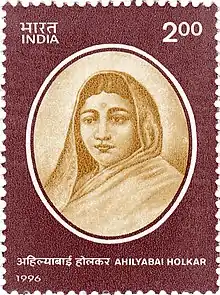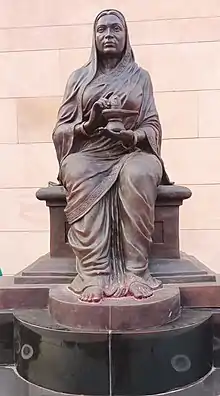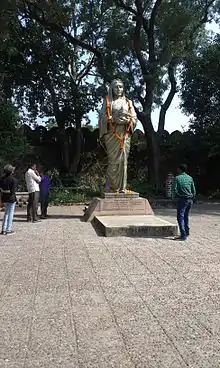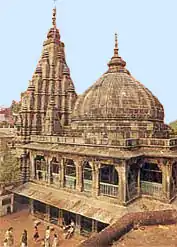| Ahilya Bai Holkar | |||||
|---|---|---|---|---|---|
 Ahilyabai Holkar on a 1996 Indian stamp | |||||
| Reign | 1 December 1767 – 13 August 1795 | ||||
| Coronation | 11 December 1767 | ||||
| Predecessor | Male Rao Holkar | ||||
| Successor | Tukoji Rao Holkar | ||||
| Regent of Indore | |||||
| Regency | 1766–1767 | ||||
| Subedar | Male Rao Holkar | ||||
| Born | 31 May 1725 Chondi, Maratha Empire (present-day Ahmad Nagar, Maharashtra, India) | ||||
| Died | 13 August 1795 (aged 70) Indore, Maratha Empire (present-day Indore, Madhya Pradesh, India) | ||||
| Spouse | Khande Rao Holkar | ||||
| Issue | Male Rao Holkar (son) Muktabai (daughter) | ||||
| |||||
| House | House of Holkar | ||||
| Father | Mankoji Shinde | ||||
| Mother | Sushila Shinde | ||||
| Religion | Hinduism | ||||
Ahilya Bai Holkar (31 May 1725 – 13 August 1795)[1] was the hereditary noble queen of the Maratha Empire, in early-modern India. She established Maheshwar (in Madhya Pradesh) as the seat of Holkar Dynasty.[2]
After the demise of her husband Khande Rao Holkar and father-in-law Malhar Rao Holkar, Ahilya Bai herself undertook the affairs of Holkar dynasty. She defended the Malwa state against intruders and personally led armies into battle, with Tukoji Rao Holkar as her military commander.[2]
Ahilya Bai was a great pioneer and builder of Hindu temples who constructed hundreds of temples and Dharmashalas.[2]
Early life

Ahilya Bai was born into a Marathi Hindu family to Mankoji Shinde and Sushila Shinde in the Chaundi village (present-day Ahmednagar district) of Maharashtra, where her father, Mankoji Shinde, a scion of a respectable Dhangar(Gadariya) family, served as the Patil.[3][4] Although women did not go to school back then, Ahilya's father taught her to read and write.[5]
According to a legend, she rose to prominence when Malhar Rao Holkar, a commander in the army of Maratha Peshwa Baji Rao I and ruler of Malwa, stopped in Chaundi on his way to Pune and saw the eight-year-old Ahilya at a temple service in the village. Impressed by her piety and character, Malhar's son Khande Rao Holkar married Ahilya, on the Peshwas advice. She married Khande Rao in 1733. Ahilya accompanied Khande Rao on many campaigns. Throughout her married life, she was brought up by her mother in law Gautama Bai who is credited today for the values instilled in Ahilya. She trained her into administration, accounts, politics etc and eventually handed over her Khasgi Jagir in 1759.[6][7]
In 1754, Khande Rao, alongside his father Malhar Rao Holkar, laid the siege of Kumher fort of Jat Raja Suraj Mal of Bharatpur on request of support from Imad-ul-Mulk and the Mughal emperor Ahmad Shah Bahadur's general Mir Bakhshi. Suraj Mal had sided with the Mughal emperor's rebellious wazir Safdar Jang. Khande Rao was inspecting his troops in an open palanquin during the battle when a cannonball fired from the Jat army hit him, leading to his death.[8] After the death of her husband, Ahilya Bai was stopped by her father in law from committing sati. After demise of her husband she was trained in military affairs by Malhar Rao Holkar.[2][5]
Reign




Ascent
After her husband Khande Rao's death, Ahilya Bai had given up all desires of life and decided to perform Sati to accompany her husband at his funeral pyre. People requested her not to commit Sati, but she said her husband had pledged to accompany her lifelong, and now he has left midway. When she had made up her mind to perform Sati and was not relenting, it was finally her father-in-law Malhar Rao who made fervent emotional appeals to stop her.[9] He said:
"Daughter, my son left me whom I raised with a hope that he would support me in my old age. Now, will you also leave me, an old man, alone to be drowned in the fathomless ocean? ... Will you also leave me without any support? Still, if you don't want to change your mind, let me die first."
Malhar Rao Holkar died in 1766, 12 years after the death of his son Khande Rao. Malhar Rao's grandson and Khande Rao's only son Male Rao Holkar became the ruler of Indore in 1766, under Ahilya Bai's regency, but he too died within few months in April 1767. Ahilya Bai became the ruler of Indore after the death of her son with Khande Rao.[10][11]
A letter to her from Malhar Rao in 1765 illustrates the trust he had in her ability when sending her on a military expedition to Gwalior with a huge artillery:
"...proceed to Gwalior after crossing the Chambal. You may halt there for four or five days. You should keep your big artillery and arrange for its ammunition as much as possible... The big artillery should be kept at Gwalior and you should proceed further after making proper arrangements for it's expenses for a month. On the march you should arrange for military posts being located for protection of the road."
This letter clearly shows that not only was Ahilya Bai militarily trained, she was also considered capable enough to run civil and military affairs. When Ahmad Shah Durrani invaded Punjab in 1765, Malhar Rao was busy fighting the Abdali-Rohilla army in Delhi. During the same time, Ahilya Bai captured the Gohad fort (near Gwalior).
Already trained to be a ruler, Ahilya Bai petitioned Peshwa Madhav Rao I after Malhar Rao and her son's death to grant her the administration of the Holkar dynasty. Some in Malwa objected to her assumption of rule, but the Holkar faction of Maratha army sided with her. The Peshwa granted her permission on 11 December 1767, with subhedar Tukoji Rao Holkar (Malhar Rao's adopted son) as her military head. She proceeded to rule Malwa in the most enlightened manner, even reinstating a Brahmin who had previously opposed her. Ahilya Bai paid regular visits to her subjects, being always accessible to anyone needing her help.
Conflict with Dewan Gangadhar Rao
Following the death of Male Raao Holkar, Gangadhar Rao, Malhar Rao Holkar's dewan, believing Ahilyabai to be a weak powerless widow, tried to usurp royal authority for himself by requesting Ahilyabai to adopt him as her son and grant all administrative power to him but she promptly refused to do so. Gangadhar Rao then orchestrated a rebellion against her and instigated Raghunathrao, uncle of Peshwa Madhavrao, to attack the Holkar domain of Indore. On coming to know about the encampment of Raghunathrao's army at the banks of the river Shipra through her spies, Ahilyabai immediately despatched letters to compatriots of her late father-in-law, Mahadji Scindia and Damaji Rao Gaekwad, asking for assistance and assembled the Holkar army with the help of Tukoji. The Bhonsales of Nagpur sent their armies to assist her and Peshwa Madhavrao authorised Ahilyabai to take offensive action against Raghunathrao. Ahilyabai herself went to the battlefield with her female bodyguards to face Raghunathrao. Seeing Ahilyabai's courage, Raghunathrao was frightened and retreated back stating that he had just come to offer condolence to Ahilyabai for the death of Male Rao. Gangadhara Rao was kept under house-arrest before being reinstated back to his former position.[12] The conflict between Ahilyabai Holkar and Dewan Gangadhar Rao had significant political and personal implications. Ahilyabai's victory helped her to establish her authority over the kingdom, but the conflict also strained her relationship with Gangadhar Rao, who was her trusted advisor and confidant.[13]
Clashes with Rajputs
Ahilyabai defended her realms from Rajput raids in the aftermath of the Rajputs defeating the Maratha army led by Mahadji Scindia at the battle of Lalsot.
Among Ahilya Bai's accomplishments was the transformation of Indore from a small village to a prosperous and beautiful city; her own capital, however, was in the nearby Maheshwar, a town on the banks of Narmada River. She also commissioned several infrastructure projects in Malwa, sponsored festivals and gave donations for regular worship in many Hindu temples. Outside Malwa, she built numerous Hindu temples, Ghats, wells, tanks and rest-houses throughout the Indian subcontinent, stretching from the Himalayas to pilgrimage centres in southern India. The Bharatiya Sanskriti Kosh lists the sites she embellished as Kashi, Gaya, Somnath, Ayodhya, Mathura, Haridwar, Kanchi, Avanti, Dwarka, Badrinath Temple, Rameshwaram and Jagannath Puri. Ahilya Bai also supported the rise of merchants, farmers and cultivators to levels of affluence and did not consider that she had any legitimate claim to their wealth, be it through taxes or feudal right.
There are many stories of her care for her subjects. In one instance, when her minister refused to allow the adoption of a child unless he was suitably bribed, she is said to have sponsored the child herself and given him clothes and jewels as a part of the adoption ritual.
Ahilya Bai could not settle the conflict peacefully in the case of the Bhils and Gonds, who unethically plundered her borders; but she granted them waste hilly lands and the right to a small duty on goods passing through their territories. Even in this case, according to Malcolm, she did give "considerate attention to their habits".
Ahilya Bai's capital at Maheshwar was the scene of literary, musical, artistic and industrial enterprise. She patronized the famous Marathi poet Moropant and the shahir Anantaphandi from Maharashtra, and also patronised the Sanskrit scholar, Khushali Ram. Craftsmen, sculptors and artists received salaries and honours at her capital and she even established a textile industry in Maheshwar.
Ahilyabai repealed a traditional law that had previously empowered the state to confiscate the property of childless widows.
In 1780, following the death of her husband preceded by the death of their 16 year old son, Ahilyabai's daughter Muktabai committed sati.
Death
Ahilyabai died on 13 August 1795 at the age of 70. Ahilyabai was succeeded by her commander-in-chief and nephew, Tukoji Rao Holkar, who soon abdicated the throne in favour of his son Kashi Rao Holkar in 1797.
Children
She gave birth to a son Male Rao and daughter Muktabai in 1745 and 1748, respectively. Male Rao became mentally ill in later life and died in 1767 due to his disease. Ahilya Bai married her daughter to Yashwant Rao, a brave but poor man, after he had succeeded in defeating dacoits.
Views about her

"The reign of Ahilyabai, of Indore in central India, lasted for thirty years. This has become almost legendary as a period during which perfect order and good government prevailed and the people prospered. She was a very able ruler and organizer, highly respected during her lifetime, and considered as a saint by a grateful people after her death."
— Jawaharlal Nehru, The Discovery of India (1946)[14]
"For thirty years her reign of peace,
The land in blessing did increase;
And she was blessed by every tongue,
By stern and gentle, old and young.
Yea, even the children at their mother's feet,
Are taught such homely rhyming to repeat.
In latter days from Brahma came,
To rule our land, a noble Dame,
Kind was her heart and bright her fame,
And Ahilya was her honored name."— Joanna Baillie, English Poem (1849)
Collecting oral memories of her in the 1820s, Sir John Malcolm, the British official most directly concerned with the 'settlement' of central India, seems to have become deeply enamored of her.
"Ahilyabai's extraordinary ability won her the regard of her subjects and of the other Maratha confederates, including Nana Phadnavis. With the natives of Malwa ... her name is sainted and she has styled an avatar or Incarnation of the Divinity. In the soberest view that can be taken of her character, she certainly appears, within her limited sphere, to have been one of the purest and most exemplary rulers that ever existed."
"This great ruler in Indore encouraged all within her realm to do their best, Merchants produced their finest clothes, trade flourished, the farmers were at peace and oppression ceased, for each case that came to the queen's notice was dealt with severely. She loved to see her people prosper, and to watch the fine cities grow, and to watch that her subjects were not afraid to display their wealth, lest the ruler should snatch it from them. Far and wide the roads were planted with shady trees, and wells were made, and rest-houses for travelers. The poor, the homeless, the orphaned were all helped according to their needs. The Bhils who had long been the torment of all caravans were routed from their mountain fastnesses and persuaded to settle down as honest farmers. Hindu and Musalman alike revered the famous Queen and prayed for her long life. Her last great sorrow was when her daughter became a Sati upon the death of Yashwantrao Phanse. Ahalya Bai was seventy years old when her long and splendid life closed. Indore long mourned its noble Queen, happy had been her reign, and her memory is cherished with deep reverence unto this day."
"From the original papers and letters, it becomes clear that she was the first-class politician, and that was why she readily extended her support to Mahadji Shinde. I have no hesitation in saying that without the support of Ahilyabai, Mahadji would never have gained so much importance in the politics of northern India."
— Historian Judunath Sarkar
"Definitely no woman and no ruler are like Ahilyabai Holkar."
"It reveals beyond doubt that all ideal virtues described by Plato and Bhattacharya were present in her personalities like Dilip, Janak, Shri Ram, Shri Krishna, and Yudhishthir. After thorough scrutiny of the long history of the world, we find only one personality of Lokmata Devi Ahilya that represents an absolutely ideal ruler."
— Arvind Javlekar[17]
John Keay called her 'The Philosopher Queen', a reference perhaps to the 'Philosopher king' Bhoj.
"Ahilyabai Holkar, the 'philosopher-queen' of Malwa, had evidently been an acute observer of the wider political scene. In a letter to the Peshwa in 1772, she had warned against association with the British and likened their embrace to a bear-hug: "Other beasts, like tigers, can be killed by might or contrivance, but to kill a bear it is very difficult. It will die only if you kill it straight in the face, Or else, once caught in its powerful hold, the bear will kill its prey by tickling. Such is the way of the English. And in view of this, it is difficult to triumph over them."
"The Great Maratha lady who affords the noblest example of wisdom, goodness, and virtue. Akbar is among male sovereigns, and Ahilyabai is among female sovereigns".
— An English writer quoted in the book Ahilya Bai Holkar by Khadpekar[19]
A commemorative stamp was issued in her honour on 25 August 1996 by the Republic of India.[20]
As a tribute to the great ruler, Indore international airport has been named Devi Ahilyabai Holkar Airport. Similarly, Indore university has been renamed as Devi Ahilya Vishwavidyalaya.[2]
Structures throughout India


.jpg.webp)
The Holkar family was known for avoiding using public cash to meet their personal and family expenses. They possessed their personal funds, which they had accumulated through their private property. Ahilyabai inherited personal funds estimated at sixteen crores rupees at the time. Ahilyabai donated money from her personal resources to charity.[21]
In 1742, the Maratha ruler Malhar Rao Holkar made a plan to demolish the mosque and reconstruct Vishweshwar temple at the site. However, his plan did not materialize, partially because of intervention by the Nawab of Awadh, who was given the control of the territory.[22] Around 1750, the Maharaja of Jaipur commissioned a survey of the land around the site, with the objective of purchasing land to rebuild the Kashi Vishwanath temple.[22]: 85 However, his plan to rebuild the temple did not materialize either. In 1780, Malhar Rao's daughter-in-law Ahilyabai Holkar rebuilt the present temple adjacent to the mosque. Ahilyabai funded the reconstruction of the Kashi Vishwanath Temple in Varanasi (Uttar Pradesh) 1780[23] which had been destroyed in the past and subsequently converted into a mosque by Aurangzeb in 1669. Construction of 9 temples including those of Shri Tarakeshwar, Shri Gangaji, Ahilya Dwarkeshwar, Gautameshwar; (re)construction of Ghats including Manikarnika Ghat, Dashashwamedh Ghat, Janana Ghat, Ahilya Ghat, Shitala Ghat; construction of Uttarkashi Dharmashala, Rameshwar Panchkoshi Dharmashala, Kapila Dhara Dharmashala and gardens.[24][25]
The present day structure of Vishnupad temple was rebuilt by Devi Ahilya Bai Holkar, in 1787, on the banks of the Falgu river.[26].Ahilyabai Holkar had crafted the temple, sent her officers to inspect and find the best stone for the temple in whole region, and they finally found munger black stone as the best choice in Jaynagar. Since there was no proper road and the mountains were very far from Gaya, the officers found another mountain where they can carve and easily bring the stone to Gaya the place was near Bathani (a small village in Gaya district). The officers brought the craftsmen from Rajasthan. They started carving the temple in Patharkatti (a village and also a tourist place in Bihar). The final temple was assembled in Gaya near Vishnupad temple site. After the completing the construction of temple many craftsmen returned to their native places, but some of them settled-down in Pattharkatti village itself. Bihar government has marked this place as one of the prominent tourist spots of Bihar.[27] The 1000 stone steps leading to the top of the Brahmajuni hill on southwest of the Vishnupad mandir gives the view of Gaya city and the Vishnupad temple, which is a tourist spot. There are also many small temples near this temple.[28]
In popular culture

- Former Lok Sabha Speaker Sumitra Mahajan has written a book "Matoshree" based on the life of Ahilyadevi Holkar.
- A film titled Devi Ahilya Bai was produced in 2002 featuring Mallika Prasad as Devi Ahilya Bai, Shabana Azmi as Harkubai (Khanda Rani, Malhar Rao Holkar's wife) and also including Sadashiv Amrapurkar as Malhar Rao Holkar, Ahilyabai's father in law.[29]
- A documentary for UGC-CEC channel VYAS was made by Educational Multimedia Research Centre, Indore about her life and times.
- In Thane City in Maharashtra, a children's park has been named as 'Ahilyadevi Holkar Udyan' after her. Also, a road has been named after her in the same city.
- The airport at Indore is named Devi Ahilya Bai Holkar Airport in her honor.
- There are two universities named Devi Ahilya Vishwa Vidyalaya in Indore, Madhya Pradesh, and Punyashlok Ahilyadevi Holkar Solapur University in Solapur, Maharashtra.
- In 2006, a statue of Ahilyabai Holkar was unveiled on the premises of the Parliament Library Building by Vice-President Bhairon Singh Shekhawat.
- In the 1994 Hindi TV series The Great Maratha, Ahilyabai's character was portrayed by Mrinal Kulkarni.
- In 2016, a TV serial titled Awaaz: Punyashlok Ahilybai Holkar aired on Colors Marathi starring Urmila Kothare as Ahilybai.
- In 2021, a TV serial titled Punyashlok Ahilyabai aired on Sony. Aditi Jaltare played the role of a young Ahilyabai followed by Aetashaa Sansgiri who is currently playing an adult Ahilyabai.
- The State Highway 15 (West Bengal) has been renamed as Ahilyabai Holkar Road.
References
- ↑ Pradesh (India), Madhya (1827). Madhya Pradesh District Gazetteers: Hoshangabad. Government Central Press. p. 64.
- 1 2 3 4 5 "Rani Ahilyabai Holkar". University of Indore.
- ↑ Khanolkar, D.D. (1979). Marathwada University Journal - Volumes 17-18. Marathwada University. p. 67.
- ↑ Bhattacharya, Sabyasachi (2002). Education and the Disprivileged Nineteenth and Twentieth Century India. Orient BlackSwan. p. 40. ISBN 9788125021926.
- 1 2 "Ahilyabai Holkar Information in English | Ahilyabai Holkar". 2 May 2020. Retrieved 3 May 2020.
- ↑ Nagrale, N.N. (1979). "Ahilyabai and Her Benevolent Administration". Proceedings of the Indian History Congress. 40: 700–706. JSTOR 44142013. Retrieved 2 June 2023.
- ↑ Abhang, C.J. (2018). "The Religious Policy of the Marathas in Malwa". Proceedings of the Indian History Congress. 79: 323–328. JSTOR 26906264. Retrieved 2 June 2023.
- ↑ Holkar, Madhusudan Rao (16 March 2021). "Khande Rao Holkar ki 267 vi Punytithi (17 March )". historyofbharat.com/. Madhusudan Rao Holkar. Retrieved 27 July 2022.
- ↑ Anne Feldhaus (21 March 1996). Images of Women in Maharashtrian Literature and Religion. SUNY Press. pp. 184–. ISBN 978-0-7914-2838-2.
- ↑ Omkareshwar and Maheshwar: Travel Guide. Goodearth Publications. 2011. pp. 60–. ISBN 978-93-80262-24-6.
- ↑ R. V. Solomon; J. W. Bond (2006). Indian States: A Biographical, Historical, and Administrative Survey. Asian Educational Services. pp. 70–. ISBN 978-81-206-1965-4.
- ↑ "अहिल्याबाई होलकार (जीवन चरित्र)". 29 April 2022.
- ↑ Meena Menon, Ahilyabai Holkar and the Reemergence of the Political: Women, Power, and the Political Sphere in Eighteenth-Century India
- ↑ Jawaharlal Nehru (1946) The Discovery of India. Meridian Books. p. 304. ISBN 978-0-19-562359-8
- ↑ Malcolm, J., A Memoir of Central India, quoted in John Keay (2000). India: A History. Grove Press. p. 407. ISBN 978-0-8021-3797-5.
- ↑ Annie Besant (2018). Children of the Motherland. CHIZINE PUBN. pp. 290–291. ISBN 978-1-377-17734-2.
- ↑ Arvind Javlekar (2002). Lokmata Ahilyabai. Ocean Books. p. 140. ISBN 978-81-88322-08-4.
- ↑ John Keay (2000). India: A History. Grove Press. p. 425. ISBN 978-0-8021-3797-5.
- ↑ Quote of an English writer given in the book Ahilya Bai Holkar by Khadpekar
- ↑ "Ahilyabai Holkar". Indianpost.com. 25 August 1996. Retrieved 17 September 2012.
- ↑ Arvind Javlekar (2002). Lokmata Ahilyabai. Ocean Books. p. 62. ISBN 978-81-88322-08-4.
- 1 2 Madhuri Desai (2007). Resurrecting Banaras: Urban Space, Architecture and Religious Boundaries. ISBN 978-0-549-52839-5.
- ↑ "Shri Kashi Vishwanath Temple – A Brief history". Archived from the original on 10 February 2007. Retrieved 1 September 2009.
- ↑ Rana P.B. Singh, The Kashi Vishwanath Temple: From Prehistoric Times to the Present, Varanasi: The City of Temples (2012).
- ↑ Yael S. Zerubavel, The Temple, the Mosque, and the Nation: The Politics of Heritage on the Banks of the Ganges, "Comparative Studies in Society and History" (2002).
- ↑ "Vishnupad Temple". Times of India. 13 July 2016.
- ↑ Martin 2012, pp. 62–64.
- ↑ Boda 1994, p. 278.
- ↑ "NFDC: Cinemas of India". Nfdcindia.com. Retrieved 17 September 2012.
Works cited
- Boda, Sharon La (1994). International Dictionary of Historic Places: Asia and Oceania. Taylor & Francis. ISBN 9781884964046.
- Martin, Robert Montgomery (2012). The History, Antiquities, Topography, and Statistics of Eastern India: In Relation to Their Geology, Mineralogy, Botany, Agriculture, Commerce, Manufactures, Fine Arts, Population, Religion, Education, Statistics, Etc. Cambridge University Press. ISBN 9781108046503.
Further reading
- In Marathi
- List of Ahilyabai Holkar Books in Marathi - AhilyaStore
- Punyashlok Ahilya by R.W.Tikore-Kumthewale
- Ahilyabai by Hiralal Sharma
- Ahilyabai Charitra by Purshottam
- Ahilyabai Charitra by Mukund Vaman Barve
- Dnyat Adnyat Ahilyabai Holakar by Vinaya Khadapekar
- Pal Samaaj on Samaaj
- Matoshree" by Sumitra Mahajan
External links
 Media related to Ahilya Bai Holkar at Wikimedia Commons
Media related to Ahilya Bai Holkar at Wikimedia Commons- Ahilyadevi Holkar: A Magnificent Ruler, Saintly Administrator
- https://ahilyabaiholkar.in/